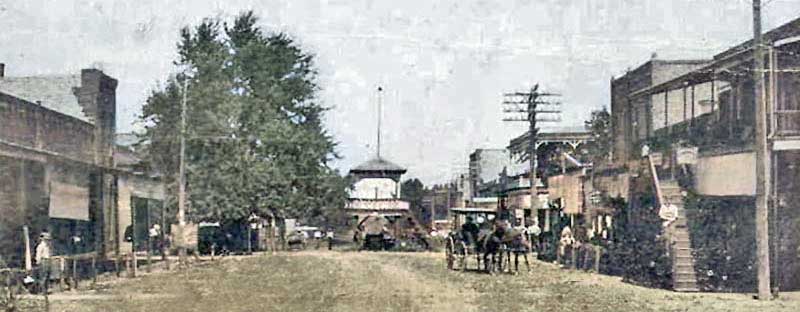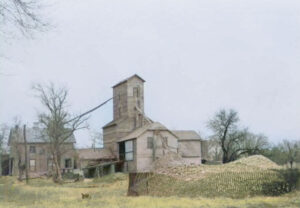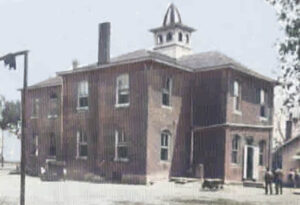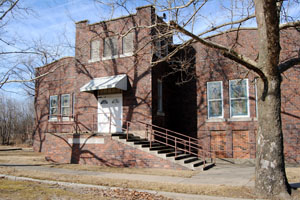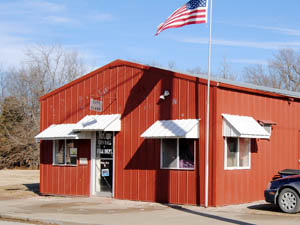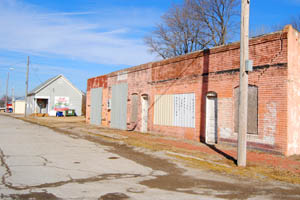McCune, Kansas, is a small town in southwest Crawford County on the divide between the Neosho River and Lightning Creek. As of the 2020 census, the city’s population was 370, and its total area is 0.31 square miles.
A post office called Time was established on January 19, 1875, half a mile north of present-day McCune. However, on August 12, 1878, it was moved to McCune, a new town named in honor of Isaac McCune, who owned and had been farming the land. J.F. McCune became the postmaster. At that time, the office consisted of a small box containing 15 pigeon holes. However, it soon became necessary to supersede this box with one considerably larger.
This area was a vast and fertile district, measured from a central point by a radius of about 15 miles to Girard on the northeast, Cherokee on the east, Columbus on the southeast, Oswego on the southwest, and Parsons on the west. The country surrounding it was filled up and well cultivated by thrifty and enterprising farmers. It was plain to see that it was a favorable point for the establishment of a town.
McCune was located on the St. Louis and San Francisco Railroad’s Parsons subdivision.
J.Z. Sherfick erected the first building, which was later used as a hotel.
In May 1879, Isaac McCune laid out the town, and the railroad civil engineer made the survey and plat. The original site comprised 60 acres. Later, R.N. Canada added ten acres to the north, C. Crank added ten acres to the west, and Isaac McCune added ten acres to the south, making the total area of the town site 90 acres.
Isaac McCune built the first store, which J.D. Rodgers opened with a stock of general merchandise. This was the second building in the town and was erected in August 1879. The next was a storehouse built by Thomas Stutterd, in which he kept drugs and dry goods. In about two months, Dr. E.P. Davis purchased it.
Daniel Hollinger taught the first school after the town was laid out. The schoolhouse was a small frame building.
The Presbyterian Church was organized in 1879 with seven members by Reverend Mr. Hill of Kansas City. The organization took place in the schoolhouse, where services were held until the churchhouse was built in 1880 and dedicated in 1881. Reverend Mr. Thayer was the first regular pastor.
In the spring of 1880, W.W. Gibson erected a building and opened a general store, and later in the fall, F.M. McCaslin built a house and added a stock of miscellaneous merchandise. This house was later occupied by Wilson & Son.
An addition was built for the school in the fall of 1881. At that time, the school had about 200 students. The school comprised three departments with as many teachers as students.
In July 1881, D.A. Burton started a paper called the McCune Standard. Subsequently, it came into the hands of his son, J.A. Burton, who, after running it for a short time, sold it to W.W. Liggett in the fall of 1882. Liggett, of the Standard office, also bought out a six-column folio paper, called the McCune Times, the first issue being made September 9, 1882.
There was also a Methodist Episcopal congregation and a Methodist organization. The former erected a church in 1882, but the latter was without a house of worship. The Christian congregation was organized in 1881, and the church was built in 1882. The United Presbyterians and Baptists also had flourishing organizations, but neither is supplied with a church building.
The town was incorporated as a city of the third class on October 8, 1881. The first officers were Mayor Isaac McCune and councilmen I.V. McCune, R.O. Harris, M. Casey, and K.P. Minard. A. Burton established the first newspaper, the McCune Standard, in that year.
By 1882, the town had made considerable progress and had 500 residents. It contained eight general stores, three hardware stores, two drug stores, two grocery stores, two millinery stores, two hotels, a billiard hall, two blacksmith shops, a cabinet shop, three carpenter shops, two lumber yards, two coal yards, two livery stables, a flouring mill, a grain elevator, and nine grain buyers.
The only manufacturing establishment was the McCune flouring mills, which were built in May 1882 by the firm of Carter & Allen. Subsequently, Carter sold out to a man named Galyon, and the firm became Allen & Galyon. The mill contained three runs of stone and turned out to be an excellent brand of goods.
The McCune Coal Company was formed in 1882 and was composed of Isaac McCune, I.K. Vance, and Jonathan Rigney. The company’s objective was to prospect for coal in the vicinity of the town. In the summer of 1882, a prospect shaft was sunk to a depth of 400 feet, which passed through five veins of coal of varying thickness. A five-foot thick vein was reached at a depth of about 350 feet. The shaft was sunk within the limits of the town, showing that beneath it lay a wealth of this mineral. The design of the company was to develop this interest in the immediate future, and thus, the city would be another great impetus to her progress. The surroundings of this young city are fovorable, and its prospects of growth in the future are to an extent certain. The country around is rich in the growth of agricultural products of all kinds, and McCune is thus rendered a vital shipping point. During the year 1882, 28 cars of oats, 88 wheat, 91 corn, 18 castor beans, five flax seed, 28 hogs, and two cattle were shipped from this station. The men of the town were live and energetic, and an extensive and prosperous business is sustained.”
By 1905, McCune had grown substantially and was one of the best towns in the county. Churches, schools, newspapers, banks, and all classes of business were well represented, and the town was a busy, thriving, prosperous place.
In 1910, McCune was still on the St. Louis & San Francisco Railroad and had two banks, a weekly newspaper called the McCune Herald, a high school, the leading church denominations, telegraph and express offices, and an international money order post office with six rural routes. Its population peaked that year at 736. In the following decades, the population continually declined.
McCune schools were closed through school unification in 2013. Students now attend Southeast School District 247, headquartered in Cherokee, Kansas.
The McCune History Museum provides many exhibits dating back to the beginning of the McCune community in 1879. Special exhibits include the Roy Rogers room and the old county school room.
©Kathy Alexander/Legends of Kansas, updated April 2025.
Also See:
Extinct Towns of Crawford County
Sources:
Blackmar, Frank W.; Kansas: A Cyclopedia of State History, Vol I; Standard Publishing Company, Chicago, IL 1912.
Cutler, William G; History of Kansas; A. T. Andreas, Chicago, IL, 1883.
Home Authors, A Twentiety Century History and Biographical Record of Crawford County, KS, 1905, by Lewis Publishing Company, Chicago, IL.
Pittsburg Memories
Wikipedia



